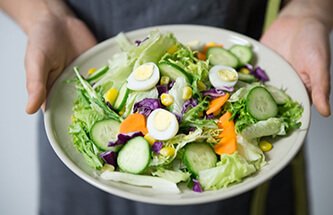5 Superfoods for Chronic Obstructive Pulmonary Disease (COPD)

By definition superfoods go beyond the basic foods on our grocery lists. These so called superfoods need to meet certain definitions. For instance, to be deemed “super”, these foods must be low in calories yet loaded with essential nutrition. Eating them should also lower the risk of certain diseases and even improve life for patients who suffer from chronic health conditions, such as chronic obstructive pulmonary disease (COPD). Of course, before consuming any new supplement, food, or diet, COPD patients should get the okay from a health professional.
Consider integrating these beneficial superfoods into your COPD diet:
1. Black tea
Tea calms nerves and soothes the soul, but studies show it also helps ease breathing for COPD patients. Black tea in particular is jam-packed with a natural bronchodilator stimulant, known as theophylline, which is derived from the xanthine alkaloids in black tea leaves. Sipping teas rich in theophylline not only helps prevent COPD, it’s also known to help open restricted airways and decrease dyspnea in COPD patients.
2. Fatty fish
If you’re a seafood lover, you’re in luck because fatty fish (i.e., herring, mackerel, sardines, salmon, and tuna) should be on your weekly grocery list. Many COPD patients are unaware that the disease is actually due to a protein deficiency, which leads to muscle loss and breathing issues. However, fatty fish, rich in omega-3 fatty acids are excellent sources of lean protein that fight chronic inflammation within the body and lungs while improving COPD symptoms.
3. Nuts
Again, COPD often occurs due to nutrient deficiency, which means COPD patients lacking adequate calories can greatly benefit from incorporating dense, high-calorie nuts and nut butters into their diets. Nuts provide an excellent source of protein, which COPD patients need. Reach for low sugar, natural nut butters (i.e., almond butter and natural peanut butters) to smear on your morning toast.
4. Whole grains
Research published by the American Journal of Epidemiology has discovered a link between high fiber diets and a decreased risk of COPD. Thankfully, fiber can be easily had in whole grains (i.e., bulgur, millet, and quinoa) as well as fruits and vegetables with skin intact versus refined carbohydrates that spike insulin levels, cause weight gain, and tax the lungs to work even harder.
5. Colorful fruits and veggies
Fresh is always best when reaching for a rainbow of fresh fruits and vegetables in your diet. However, for COPD patients, fruits and vegetables that are jam-packed with phytochemicals and antioxidants can help lower inflammation and cell damage within the body and lungs. Reach for colorful, fibrous, non-gassy fruits and veggies, such as:
- Apples
- Carrots
- Pears
- Squash
- Grapes
- Leafy greens
- Melons
- Citrus fruits
- Peas
- Sweet potatoes
- Berries



